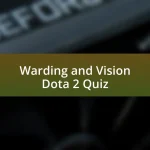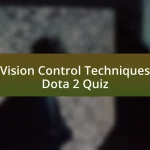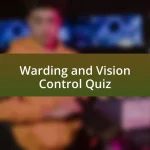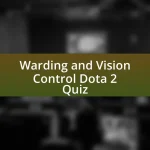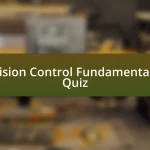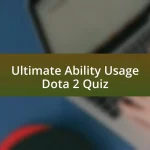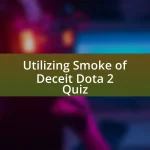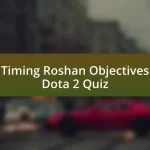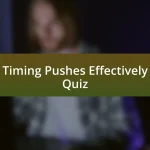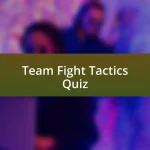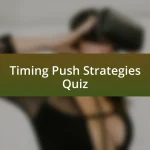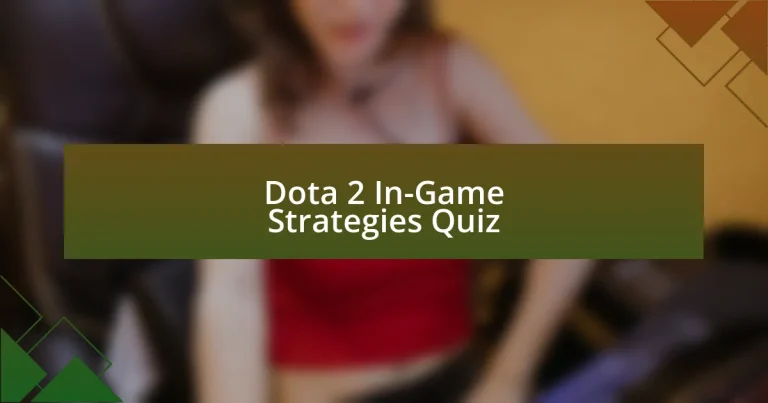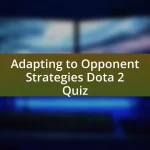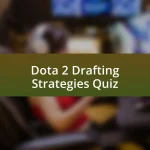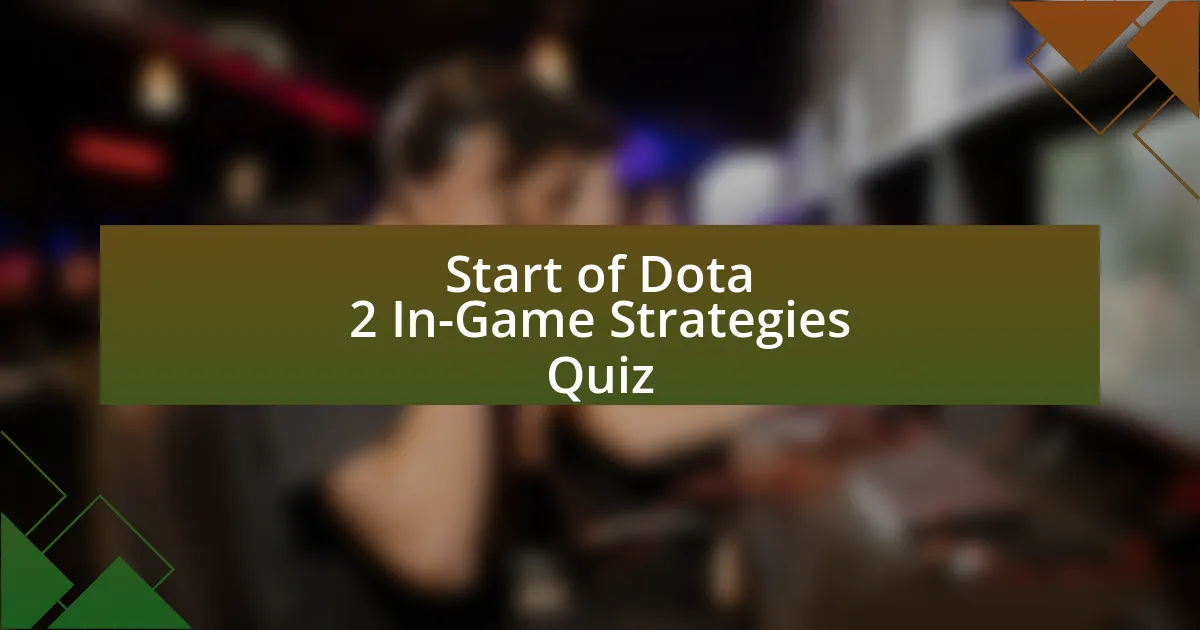
Start of Dota 2 In-Game Strategies Quiz
1. What is the primary objective in Dota 2?
- Destroy the enemy`s ancient
- Collect all runes on the map
- Kill all enemy heroes first
- Secure all towers and barracks
2. Why is staying updated with patch notes important?
- It allows players to ignore important game details.
- It provides entertainment without educational value.
- It reduces the player`s skill level in the game.
- It helps in understanding the changes in the game mechanics and strategies.
3. What should you prioritize in Dota 2?
- Objectives over kills.
- Farming over pushing lanes.
- Individual stats over team goals.
- Kills over map control.
4. Why is team coordination crucial in Dota 2?
- It focuses solely on accumulating more kills than the enemy team.
- It involves creating a vision, sharing enemy locations, and planning engagements around timings.
- It is primarily about controlling map objectives without teamwork.
- It relies on individual skill and performance without communication.
5. How do you handle a team fight effectively?
- Focus only on getting kills instead of objectives.
- Attack the strongest enemy first without consideration.
- Prioritize disabling the carry while killing the support first.
- Ignore team communication and play solo during the fight.
6. What should you avoid in a team fight?
- Focusing on enemy towers.
- Wasting heavy hitting abilities on tanky heroes.
- Ignoring team communication.
- Targeting support heroes first.
7. How do you position yourself in a team fight?
- Remain at the backline and avoid all fights completely.
- Charge into the middle and attack the enemy support champions.
- Follow the tank hero closely without any positioning strategy.
- Stay out of the central scrum if you are a carry or lightly armored hero, and stick to the outer fringes of the fight.
8. When should you run away from a team fight?
- If the enemy team initiated perfectly on you and has one or more members of your team incapacitated.
- If your carry is dealing damage to the enemy team.
- When your team has a significant advantage over the enemy.
- When the enemy team is low on health.
9. Why is mastering the minimap important?
- It helps in tracking enemy movements and planning strategies.
- It decreases your ability to map objectives efficiently.
- It is primarily for identifying battle locations only.
- It reduces awareness of your team`s actions in the game.
10. How do you handle a downswing in ranked matches?
- Keep aiming for high MMR regardless of performance issues.
- Blame teammates for losses and avoid playing with them.
- Focus on individual performance rather than MMR wins and losses.
- Ignore the game entirely and take a break for weeks.
11. What should you review after a game?
- The match statistics to see team kills and deaths.
- The enemy team`s picks to analyze their strategy.
- The chat logs for communication breakdowns.
- Your own replays to identify personal mistakes and areas for improvement.
12. How do you improve your team`s performance?
- Watch replays, practice consistently, and use effective communication during matches.
- Rely solely on luck and hope for better outcomes.
- Avoid teamwork and focus on personal kills only.
- Only play with your best friends, ignoring teamwork.
13. What is the role of wards in Dota 2?
- They act as a teleportation point for players.
- They grant vision and help in tracking enemy movements.
- They provide extra health and mana to your heroes.
- They increase the damage of your abilities.
14. Where should you place wards?
- Inside the enemy base.
- Strategic areas such as junctions.
- Random spots on the map.
- Only near enemy towers.
15. Why is farming important in Dota 2?
- It helps in earning gold and experience, which are essential for item purchases and character development.
- It encourages running into enemy towers without caution.
- It allows players to avoid skill shots from opponents.
- It distracts players from team fights and objectives.
16. How do you balance offense and defense in Dota 2?
- Focus only on attacking enemy heroes and ignore objectives.
- Defense should be prioritized over offense, especially when protecting team structures.
- Concentrate solely on farming without engaging in fights.
- Always go for kills before securing any strategic points.
17. What is the significance of understanding match cycles for your hero?
- It has no impact on how you should play your hero.
- It helps in timing your actions and strategies according to your hero`s abilities and strengths.
- It is only important for the support role in the game.
- It focuses solely on farming gold efficiently at all times.
18. How do you handle a situation where the enemy team is on a roll?
- Ignore the enemy team and keep playing your own game.
- Engage without a plan and hope for the best.
- Focus solely on killing the smallest enemy heroes first.
- Identify the key enemy heroes and focus on taking them out to disrupt their momentum.
19. What is the role of a support player in a team fight?
- The support player should protect the carry and provide necessary abilities to disable the enemy team.
- The support player should avoid using abilities during the fight to save them for later.
- The support player should always lead the team into fights without regard for safety.
- The support player should focus solely on dealing damage to the enemy team.
20. How do you counter a Smurf player in a game?
- Ignore the Smurf and play your own game.
- Play solo and avoid teamwork.
- Focus on the Smurf player and work with your teammates to take them out.
- Only focus on farming and securing items.
21. What is the importance of positioning in a team fight?
- Good positioning helps in avoiding unnecessary damage and staying safe while dealing damage to the enemy team.
- Positioning is irrelevant if you have strong items.
- Positioning doesn`t affect the outcome of the fight significantly.
- Positioning is only important for initiating fights.
22. How do you make an escape plan during a team fight?
- Charge forward and try to kill as many enemies as possible.
- Stay in the center of the fight and hope for backup.
- Ignore the fight and focus on farming nearby creeps.
- Identify when the fight is going against you and make a quick escape to safety.
23. What is the significance of observing the opponent`s actions?
- It ensures that all your abilities recharge faster.
- It helps in predicting their strategies and preparing countermeasures.
- It gives you a chance to sneak past the enemy team.
- It allows you to avoid fighting altogether.
24. How do you use wards effectively?
- Place wards in strategic areas to gain vision and disrupt the enemy team`s movements.
- Ignore wards entirely during the game.
- Sell wards for gold as soon as they are placed.
- Use wards to attack enemy towers directly.
25. What is the role of a tanky hero in a team fight?
- The tanky hero should absorb damage and protect the carry while making it to the enemy carries.
- The tanky hero should deal the most damage in the fight without worrying about defense.
- The tanky hero should focus on stealing enemy farm and maximizing gold gain.
- The tanky hero should prioritize healing teammates instead of engaging the enemy.
26. How do you balance between taking objectives and killing enemy heroes?
- Always ignore kills and focus solely on farming.
- Prioritize objectives over kills, but be prepared to take out enemy heroes when necessary.
- Take down enemy heroes first, then focus on objectives.
- Focus on kills only, and let objectives fall behind.
27. What is the importance of reviewing replays?
- It increases the overall popularity of the game among viewers.
- It enhances the skills of all players involved in the game.
- It determines the winner of the match and awards prizes.
- It helps in identifying personal mistakes and areas for improvement.
28. How do you handle a situation where the enemy team is using a specific strategy?
- Switch to a completely different hero and abandon your team.
- Focus solely on farming and avoid engaging with the enemy.
- Ignore their strategy and continue playing your own game without changes.
- Adapt your strategy to counter their approach, and be prepared to adjust your plans during the fight.
29. What is the significance of effective communication in Dota 2?
- It enhances the graphics quality and overall visual appeal of the game.
- It increases the chance of winning solo matches and earning more gold.
- It helps in coordinating team strategies, sharing enemy locations, and planning engagements.
- It reduces the need for teamwork and allows players to play independently.
30. How do you manage your gold and experience effectively?
- Invest in items that bring more gold, and try to farm longer without returning to the base.
- Constantly return to the base to spend gold.
- Spend all your gold immediately to help your team.
- Ignore farming and focus only on kills.
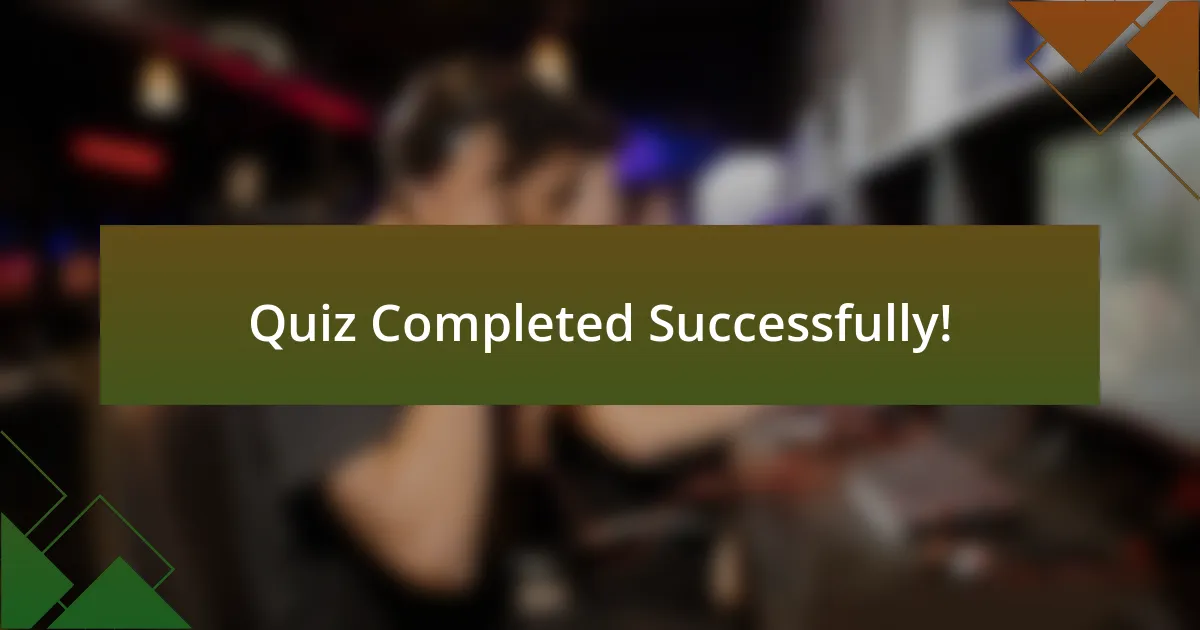
Quiz Completed Successfully!
Congratulations on completing the quiz on ‘Dota 2 In-Game Strategies’! We hope you found this quiz both enjoyable and informative. Engaging with the questions likely deepened your understanding of important strategies, hero roles, and team dynamics. Quiz sessions like this can illuminate key concepts that improve your gameplay and decision-making skills.
Throughout the quiz, you probably discovered various tactics that can be applied in real matches. From effective item builds to understanding map control, the insights gained can provide you with a competitive edge. This knowledge is crucial as Dota 2 is a constantly evolving game, where staying updated with strategies is vital for success.
If you want to expand your understanding even further, we encourage you to check out the next section on this page about ‘Dota 2 In-Game Strategies.’ You’ll find in-depth resources and guides that will enhance your gameplay knowledge. Dive deeper into the world of Dota 2 and take your skills to the next level!
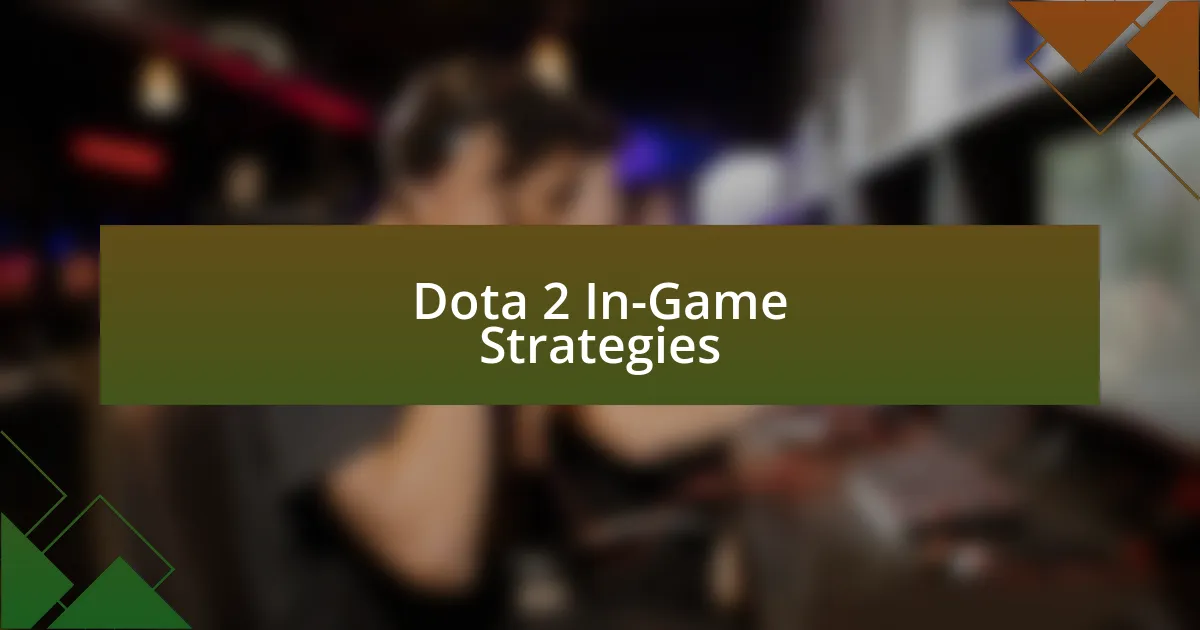
Dota 2 In-Game Strategies
Understanding Dota 2 In-Game Strategies
Dota 2 in-game strategies refer to the planned approaches players use to achieve victory. These strategies involve coordination, teamwork, and specific tactics based on heroes and their abilities. A successful strategy adapts to the game state, focusing on map control, resource management, and timing of engagements. Players analyze enemy compositions and adjust their strategies accordingly, leading to dynamic gameplay. Effective communication and role assignment are crucial components.
Map Control and Vision Strategies
Map control refers to the ability to dominate specific areas of the map through presence and vision. Establishing vision with wards is essential for gathering information. This enables teams to make informed decisions about ganks, objectives, and resource acquisition. Controlling high ground and key areas, like Roshan, can provide significant advantages. Regularly dewarding enemy vision and placing aggressive wards helps maintain map superiority.
Hero Synergy and Composition Strategies
Hero synergy involves selecting heroes that complement each other’s abilities and strengths. A balanced composition typically includes tank, damage dealer, and support roles. Certain heroes work better together; for example, a hero with crowd control can set up kills for burst damage dealers. Understanding how heroes interact allows teams to execute combinations effectively, capitalizing on enemy weaknesses and creating opportunities for team fights.
Timing and Objective-based Strategies
Timing in Dota 2 relates to executing strategies at the right moments. This includes when to engage in fights, push lanes, or secure objectives like towers and Roshan. Teams should communicate about item powerspikes, hero cooldowns, and their timing relative to opponents. Specific objectives often dictate a team’s strategy; for instance, taking a decisive fight before the enemy’s key abilities are available can turn the tide of the game.
Adapting Strategies During Gameplay
Adapting strategies during gameplay is crucial as the game evolves. Players must assess and respond to changing dynamics, such as unexpected deaths or item acquisitions. Recognizing when to shift from aggressive plays to a more defensive posture can prevent over-commitment. Insights gained from enemy movements, item builds, and team compositions inform adjustments. Flexibility in strategy often leads to better chances of success in unpredictable scenarios.
What are some common Dota 2 in-game strategies?
Common Dota 2 in-game strategies include split pushing, team fighting, and objective control. Split pushing involves one or more heroes applying pressure on different lanes to draw enemy attention away from key objectives. Team fighting focuses on grouping up to engage the enemy and secure kills or objectives. Objective control emphasizes taking down towers, Roshan, and barracks to secure an advantage. The effectiveness of these strategies largely depends on the heroes chosen and their synergy, which can lead to victory when executed correctly.
How can players effectively execute team fights in Dota 2?
Players can effectively execute team fights by coordinating their abilities and positioning. Communication is crucial; players must understand timing to use initiation and follow-up abilities effectively. Moreover, focusing on key enemy heroes, such as those with significant damage output or crowd control, helps secure an advantage. Proper use of vision through wards enhances awareness, allowing teams to choose when to engage or retreat. These tactics contribute to winning team fights consistently.
Where should players focus their efforts in the early game?
Players should focus their efforts on securing farm and experience in lanes while also contesting runes. Early game strategy involves prioritizing last-hitting creeps to gain gold and denying enemy creeps to limit their resources. Players often rotate to assist allies in securing kills or mitigating aggression from the enemy. Additionally, controlling the bounty runes at the two-minute mark is critical for gaining a gold and experience advantage. This foundational strategy enables better scaling into the mid and late game.
When is the best time to attempt Roshan in Dota 2?
The best time to attempt Roshan is when the enemy team is either dead, out of position, or preoccupied with objectives elsewhere. Teams should aim to take Roshan after winning a team fight or leveraging a significant manpower advantage. Additionally, utilizing heroes with high damage output to Roshan or those with healing abilities can expedite the process. Awareness of enemy buyback status and vision control around the Roshan pit are crucial for executing this strategy safely.
Who should lead the strategy discussions in a Dota 2 match?
The team captain or designated shot-caller should lead the strategy discussions in a Dota 2 match. This player is typically responsible for making tactical decisions based on the state of the game, coordinating plays, and communicating plans to the team. The shot-caller utilizes knowledge of the game, including map awareness and team compositions, to direct the team’s actions effectively. Having a strong leader enhances teamwork and the execution of various strategies throughout the match.

